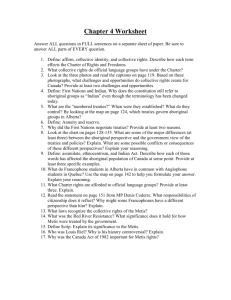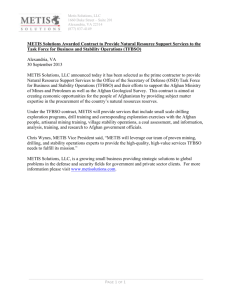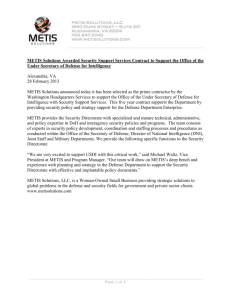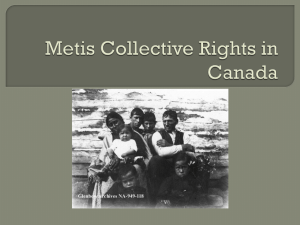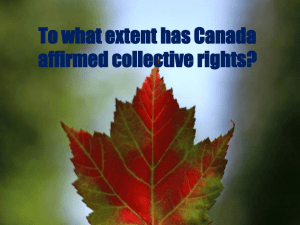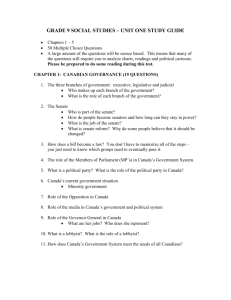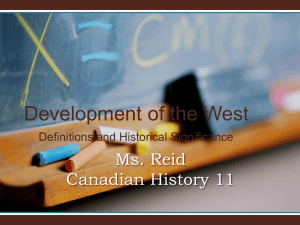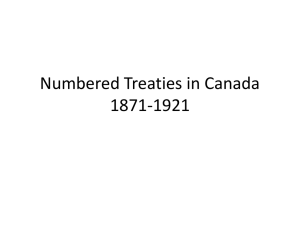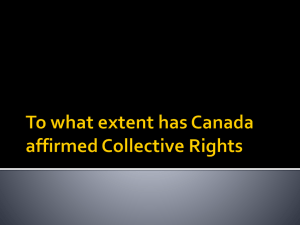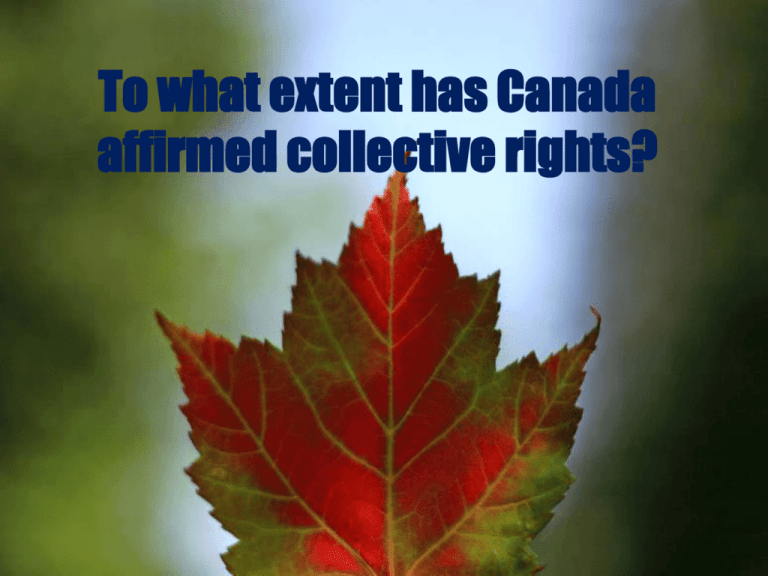
To what extent has Canada
affirmed collective rights?
What are collective
rights?
Why do only some people
have collective rights?
• Rights held by
Canadians who
belong to one of
several groups in
society.
• Collective rights
recognize the founding
peoples of Canada.
• Canada wouldn’t exist
today without the
• They are recognized
contribution of these
and protected by
peoples.
Canada’s constitution.
Who holds collective rights in
Canada?
•Aboriginal peoples, including First
Nations, Metis and Inuit people
•Francophones including the Metis
•Anglophones
FIRST NATIONS COLLECTIVE RIGHTS
THE NUMBERED TREATIES
These medals were
struck to
commemorate the
Numbered Treaties.
This medal dates from
1874. The images are
meant to convey a
specific message.
What was it? What
clues are there in the
images?
Eleven "Numbered Treaties" were
signed between 1871 and 1921 as
the Canadian government began to
pursue settlement, farming and
resource development in the west
and north of the country.
The terms of the treaties differed,
but in most cases First Nations
agreed to share their land and
resources in exchange for
education, hunting and fishing
rights, reserves, farming assistance
and annuities.
For example, Treaty 7 made
provisions for one square mile of
land for each Indian family, plus a
limited supply of cattle, some farm
equipment (one plow for each
band) and a small amount of
treaty and ammunition money.
The treaty also made limited
commitments on the part of the
Queen to provide education for
children and in some cases,
medical services.
RESERVES
This map
shows the
location of
First Nation
reserves in
Alberta.
Land set
aside for the
exclusive
use of First
Nations
Both the Canadian government
and the First Nations had their
own reasons for signing the
Numbered Treaties. Use the
following pictures to determine
what the reasons could have been.
The eradication of the
buffalo meant social and
economic upheaval for
some First Nations peoples.
They saw the Treaties as a
way to secure their future.
• BC had joined Confederation on the
condition that Canada would build a railway
within ten years to link the province with the
rest of Canada.
• The railway also allowed a large number of
immigrants to migrate to Canada’s West in
hopes of a better life. They had been
promised land by the government.
• Both of these issues required that Canada
obtain land from the First Nations.
Small pox
epidemics had
taken a horrible
toll on the First
Nations both
socially and
economically.
Both First Nations and Canada’s government wanted
to avoid wars over territory like those happening in
the United States. The treaties provided a peaceful
way of meeting the needs of both groups.
WHAT DO YOU THINK?
Do you feel that the needs of both parties the Canadian government and the First
Nations - were equal? Did one group need
the Treaties more than the other?
Did both groups benefit equally??
The perspective of each group
played a role in how they
negotiated and interpreted the
Treaties:
Treaty negotiations took place in
several languages and relied on
interpreters. Sometimes meaning
or connotation was lost in the
translation and the two parties
came away with a different view of
what had been agreed to.
First Nations recorded the Treaties in
their own language as oral histories
while Canada’s government recorded
them in written English. What problems
could arise from this?
Sometimes the oral history and
the written word don’t agree.
First Nations never believed that land
could be “owned” - they did not
understand the European practice of
fencing land - and therefore, see the
Treaties as an agreement to share the
land with the Canadian government;
however, the government believes the
First Nations gave up their land under
the Treaties.
Treaty Number Six has a provision for health
care. One clause allows a medicine chest to be
kept in the Indian agent’s home for the use and
benefit of the First Nations. Some people felt that
this provision extended to everyone who signed
the Numbered Treaties. Others went so far as to
later interpret this provision as an eternal
promise by the government to provide free health
care to all First Nations people in Canada.
Numbered Treaties Video
http://www.aincinac.gc.ca/al/hts/cys/index-eng.asp
“What collective rights do
official language groups have
under the Charter?”
What are official language
minorities?
• Canada has two official languages, English and
French
• French is spoken predominantly in Quebec
• In Nunavut, Inuktitut is predominantly spoken
• But what makes a language a minority?
• Minority means a small group within a larger group
• Francophones (people who speak French) who live in
Alberta are considered to be part of a language minority
• Francophone schools affirm the identity of Francophone
students, their families, and their communities
• Anglophones (people who speak English) are considered a
language minority in Quebec
• There are Francophone schools throughout Canada just as
there are Anglophone schools throughout Quebec
What are the Charter rights of
official language groups?
• Official bilingualism: sections 16 to 20 of
the Charter establish French and English as
official languages of Canada, and the right
of Canadian citizens to conduct their affairs
with the federal government in either
official language
• These sections also establish New
Brunswick as an officially bilingual
province
Continued
• Minority language education rights: section 23 of
the Charter says that a French-speaking or
English-speaking minority population of sufficient
size in any province has the right to publicly
funded schools that serve their language
community
• this made it possible for Francophones to maintain
their own education rights in a predominantly
English-speaking nation
Official Languages Act
• The Official Languages Act of 1969 stated that: “French
and English to be the official languages of Canada, and
under which all federal institutions must provide their
services in English or French at the customer's choice. The
Act (passed following the recommendation of the Royal
Commission on BILINGUALISM AND
BICULTURALISM) created the office of Commissioner
of Official Languages to oversee its implementation.
Politically, the Act has been supported by all federal
parties, but the public's understanding and acceptance of it
has been mixed. In June 1987 the Conservative
government introduced an amended Official Languages
Act to promote official language minority rights.”
The Metis: descendants of First
Nations peoples and French
settlers
• The Metis are one of Canada’s Aboriginal
peoples under Canada’s constitution
• However, unlike the First Nations, the
Metis do not have any historic treaties with
Canada’s government
• They believe they have inherent rights,
which are rights they have strictly because
they are First Peoples
Metis
• Today, the Metis are represented in Canada
by several organizations
• Two are in Alberta: the Metis Nation of
Alberta and the Metis Settlements General
Council
• The Metis speak French, therefore they are
Francophones
What laws recognize the
collective rights of the Metis?
• Quick timeline:
• 1869-1870: Metis-led Red River Resistance resulted in the
Manitoba Act, passed by Canada’s parliament, which
made Manitoba a bilingual province and gave land rights
to the Metis people
• 1875-1879: Canada’s government changed its mind and
instead offered issued “scrip” to the Metis, which was a
document that could be exhanged for land. In other words,
instead of establishing Metis lands in Manitoba, they gave
them a choice: accept scrip or become Treaty Indians
under the Numbered Treaties (which do you think they
would want?)
• 1885: the Northwest Resistance sought to protect
Metis lands in what is today Saskatchewan where
the railway was being laid and settlers were
moving in
• Two different interpretations of this event: the
Metis view it as a way to assert their rights, the
government saw it as a threat to their authority
• 1938: after being forced to move their settlements
constantly over a long period, L’Association des
Metis de l’Alberta et des Territoires du NordOuest lobbied Alberta’s government to set aside
land for the Metis
• Alberta’s government then passed the Metis
Population Betterment Act, which
established twelve temporary Metis
settlements
• 1940-1960: unfortunately, these settlements
still did not give the Metis control of their
land and were closed when the land became
less useful for farming and hunting
• 1982: the Metis lobbied for recognition of
Metis rights in Canada’s constitution and
were successful
• Finally, in 1990, Alberta’s government enacted
legislation under which the Metis received the
Metis settlements as a permanent land base with
the right to manage their own affairs. The
legislation included:
• Constitution of Alberta Amendment Act
• Metis Settlements Accord Implementation Act
• Metis Settlements Act
• Metis Settlements Land Protection Act
• 2003: Supreme Court ruled that the Metis have the
right to hunt and fish as one of Canada’s
Aboriginal peoples under the constitution
How do the Metis see their
rights?
• In 1996, the president of the
Metis Nation of Alberta,
Audrey Poitras said: “One of
the fundamental aspects of
Metis rights is our ability to
define ourselves. It’s not up
to the government, or nonMetis people, to define who
is Metis. Only the Metis
Nation itself can make those
kinds of distinctions.”
Different Perspectives of the
Treaties and of Collective Rights
in Canada
The following are quotes and ideas taken from different
points in history from different perspectives concerning those
who hold collective rights in Canada. From whose
perspective are they from?
1876
“What I will promise, and what I believe and hope you will
take, is to last as long as the sun shines and the rivers flow....I
see the Queen’s Councillors taking the Indian by the hand
saying we are brothers, we will lift you up, we will teach you,
if you will learn, the cunning of the white man....I see Indians
gathering, I see gardens growing and houses building; I see
them receiving money from the Queen’s commissioners to
purchase clothing for their children; at the same time, I see
them enjoying their hunting and fishing as before, I see them
retaining their old modes of living with the Queen’s gift in
addition.”
1876
“What we speak of will last as long as the sun shines
and the river runs. We are looking to the future of
our children’s children.”
1879
“Residential schools allow “aggressive civilization”
by separating the children from the
parents....Residential schools make a certain degree
of civilization within the reach of Indians despite the
deficiencies of their race....The Indians realize they
will disappear.”
1939
“The economic adjustment of the Indians to modern life is a large
problem. We need to make the Indians lead the normal life of the
ordinary Canadian citizen.”
1946
“We made treaties with Great Britain and the trust was given to the
Canadian government to live up to our treaties. Ever since the first
Treaties, First Nations have felt that Canadian officials have not
complied with those treaties.”
1969
“Canada cannot be a just society and keep discriminatory legislation
on its statute book. The barriers created by special legislation, such
as treaties, can generally be struck down. The treaties need to be
reviewed to see how they can be equitably ended.”
1970
“To preserve our culture it is necessary to preserve our status, rights,
lands and traditions. Our treaties are the basis of our rights....the
treaties are historic, moral, and legal obligations.....The government
must declare that it accepts the treaties as binding.....”
1982
“I speak of a Canada where men and women of Aboriginal ancestry,
of French and British heritage, of the diverse cultures of the world,
demonstrate the will to share this land in peace, in justice, and with
mutual respect.”
“If Canada is to survive, it can
only survive in mutual respect
and in love for one another.”

